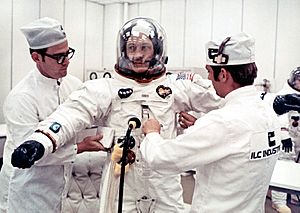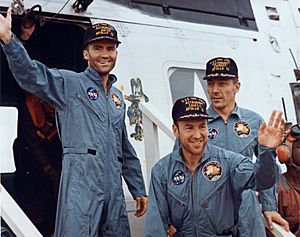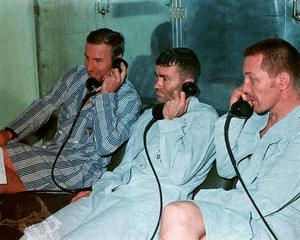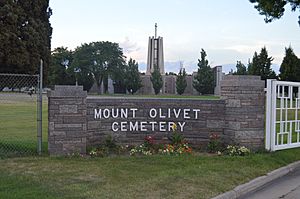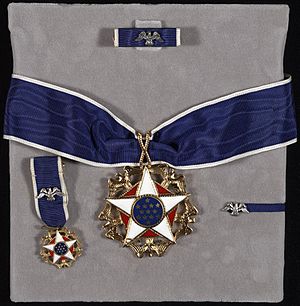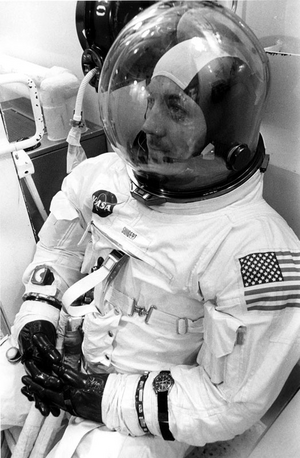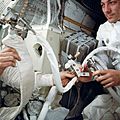Jack Swigert facts for kids
Quick facts for kids
John L. Swigert Jr.
|
|
|---|---|
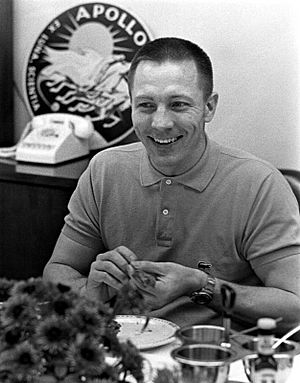
Swigert in April 1970
|
|
| Member-elect of the U.S. House of Representatives from Colorado's 6th district |
|
| In office November 2, 1982 – December 27, 1982 |
|
| Preceded by | Constituency established |
| Succeeded by | Daniel Schaefer |
| Personal details | |
| Born | August 30, 1931 Denver, Colorado, U.S. |
| Died | December 27, 1982 (aged 51) Washington D.C., U.S. |
| Resting place | Mount Olivet Cemetery, Wheat Ridge, Colorado |
| Nationality | American |
| Political party | Republican |
| Parents | John L. Swigert, M.D. Virginia Swigert |
| Alma mater | University of Colorado, B.S. 1953 Rensselaer Polytechnic Institute, M.S. 1965 University of Hartford, MBA 1967 |
| Occupation | Fighter pilot, test pilot |
| Military service | |
| Allegiance | |
| Branch/service | U.S. Air Force (1953–1956) MA ANG (1957–1960) CT ANG (1960–1965) |
| Years of service | 1953–1965 |
| Rank | |
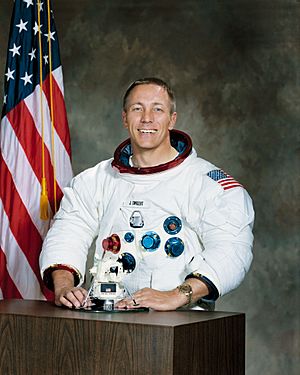 |
|
| Nationality | American |
| Occupation | Fighter pilot, test pilot |
| Awards | |
| Space career | |
| NASA astronaut | |
|
Time in space
|
5d 22h 54m |
| Selection | 1966 NASA Group 5 |
| Missions | Apollo 13 |
|
Mission insignia
|
|
| Retirement | August 1977 |
John Leonard "Jack" Swigert Jr. (August 30, 1931 – December 27, 1982) was an American test pilot, mechanical and aerospace engineer, United States Air Force pilot, and NASA astronaut, one of the 24 people who have flown to the Moon.
Before joining NASA in 1966, Swigert was a civilian test pilot and fighter pilot in the Air National Guard. After leaving NASA, he was elected to Congress from Colorado's new 6th district, but died before being sworn in.
Contents
Early life and education
Born in Denver, Colorado, at the age of 14, he became fascinated by aviation. While he would have been content just watching planes take off from nearby Combs Field, young Jack became determined to do more than be a spectator. He took on a newspaper route to earn money for flying lessons, and by age 16 he was a licensed private pilot.
Swigert received a Bachelor of Science degree in Mechanical Engineering in 1953, where he also played football for the Buffaloes. He later earned a Master of Science degree in Aerospace Engineering in 1965, and a Master of Business Administration degree in 1967; and was presented an Honorary Doctorate of Science degree in 1970, and an Honorary Doctorate of Laws degree in 1970, and an Honorary Doctorate of Science in 1970.
His recreational interests included golf, handball, bowling, skiing, swimming, and basketball. His hobbies included photography. He was a member of the Boy Scouts of America and attained the rank of Second Class Scout.
Flight experience
Following his graduation from Colorado in 1953, Swigert joined the U.S. Air Force. Upon graduation from the Pilot Training Program and Gunnery School at Nellis Air Force Base, Nevada, he was assigned as a fighter pilot in Japan and Korea. In the latter nation, he experienced his first narrow escape from death. According to the New York Times, "His plane crashed into a radar unit on a Korean airstrip and burst into flames." He walked away from the accident with minor injuries.
After completing his tour of active duty in the Air Force, he served as a jet fighter pilot with the Massachusetts (1957–1960) and Connecticut Air National Guard (1960–1965). Swigert held a position as engineering test pilot for North American Aviation before joining NASA. He was previously an engineering test pilot for Pratt & Whitney, from 1957 to 1964. He logged over 7,200 hours in flight, with more than 5,725 in jet aircraft.
NASA career
After unsuccessfully applying for NASA's second and third astronaut selections, Swigert was accepted into the NASA Astronaut Corps as part of NASA Astronaut Group 5 in April 1966. Swigert became a specialist on the Apollo Command Module: he was one of the few astronauts who requested to be command module pilots.
Apollo 13
Swigert was one of three astronauts aboard the Apollo 13 moon mission launched April 11, 1970. Originally part of the backup crew for the mission, he was assigned to the mission three days before launch, replacing astronaut Ken Mattingly. The prime crew had been exposed to German Measles (the rubella virus) and, because Mattingly had no immunity to the disease, NASA did not want to risk his falling ill during critical phases of the flight.
The mission was the third lunar-landing attempt, but was aborted after the rupture of an oxygen tank in the spacecraft's service module. Swigert was the astronaut who made the dramatic announcement, "Houston, we've had a problem here". The statement was then repeated by Commander of the flight Jim Lovell. Swigert, along with fellow astronauts Lovell and Fred Haise, returned safely to Earth on April 17 after about 5 days and 23 hours, and received the Presidential Medal of Freedom the next day.
Post-NASA career
Swigert took a leave of absence from NASA in April 1973 to become executive director of the Committee on Science and Astronautics, U.S. House of Representatives.
Swigert eventually left NASA and the committee in August 1977, to enter politics. In 1979, he became vice president of B.D.M. Corporation, Golden, Colorado. In 1981, Swigert left BDM to join International Gold and Minerals Limited as vice president for financial and corporate affairs.
In February 1982, Swigert left International Gold and Minerals Limited to run for U.S. Congress as a Republican. On November 2, 1982, Swigert easily won the seat in the state's new 6th congressional district with 64% of the popular vote.
Death
In 1982, during his political campaign, Swigert developed a malignant tumor in his right nasal passage. He underwent surgery, but the cancer spread to his bone marrow and lungs. Seven weeks after the election, he was airlifted on December 19 from his home to Georgetown University Hospital in Washington, D.C., and died of respiratory failure on December 27, eight days before the beginning of his congressional term. He died at the age of 51. He is buried in Mount Olivet Cemetery in Wheat Ridge, Colorado.
Organizations
Swigert was a member of numerous organizations. He was a fellow of the American Astronautical Society; associate fellow of the Society of Experimental Test Pilots and the American Institute of Aeronautics and Astronautics; and member of the Quiet Birdmen, Phi Gamma Delta, Pi Tau Sigma, and Sigma Tau.
Awards and honors
- American Institute of Aeronautics and Astronautics (AIAA) Octave Chanute Award for 1966 (for his participation in demonstrating the Rogallo Wing as a feasible land landing system for returning space vehicles and astronauts)
- Presidential Medal of Freedom, 1970
- NASA Distinguished Service Medal
- American Astronautical Society Flight Achievement Award, 1970
- City of New York City Gold Medal, 1970
- City of Houston Medal for Valor, 1970
- City of Chicago Gold Medal in 1970
- University of Colorado-Boulder's Distinguished Engineering Alumnus Award in 1970
- AIAA Haley Astronautics Award, 1971
- Antonian Gold Medal, 1972
Legacy
- In 1983, Swigert was inducted into the International Space Hall of Fame
- In 1988, Jack Swigert was nominated and inducted into the Colorado Aviation Hall of Fame
- In 1995, Swigert was portrayed by Kevin Bacon in Ron Howard's film Apollo 13
- In 1997, a statue of Swigert made by George and Mark Lundeen was placed on display in the U.S. Capitol Building as one of two statues given by the state of Colorado to the National Statuary Hall Collection. As of December 2008 the statue is on display in Emancipation Hall in the United States Capitol Visitor Center. A duplicate statue is currently on display at Denver International Airport
- In 1997, Jack Swigert was inducted into the U.S. Astronaut Hall of Fame
- In September 2003, John L. Swigert Jr. was elected to the Rensselaer Polytechnic Institute Alumni Hall of Fame
- In 2004, the Space Foundation launched the John L. "Jack" Swigert Jr. Award for Space Exploration, which is presented annually to an individual, group or organization that has made a significant contribution to space exploration
- On August 18, 2009, the Space Foundation and Colorado Springs District 11 partnered together to open the Jack Swigert Aerospace Academy
Images for kids
-
Swigert, at right, with the "mailbox" rig improvised to adapt the Apollo 13 command module's square carbon dioxide scrubber cartridges to fit the lunar module, which took a round cartridge
See also
 In Spanish: Jack Swigert para niños
In Spanish: Jack Swigert para niños


